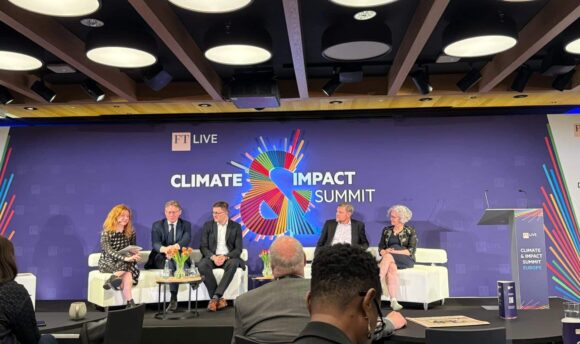Global wind power capacity must grow eight- and solar capacity five-fold by 2030 so we can limit global warming to 1.5°C, the International Renewable Energy Agency has found. Scaling up the renewable energy sector is all the more urgent in order to replace Russian fossil fuels with wind and solar rather than new oil and gas projects.
Like other power infrastructure projects, renewable energy installations face numerous risks. Technical innovations, for example, may turn out to be less reliable than expected. Suppliers may not be able to provide essential inputs during project construction. Off-takers may renege on their contracts. Once the projects are operational, natural perils such as windstorms can damage rotors or hail might crack solar panels. Governments may cancel tax credits, regulations may change, and rising interest rates could make projects unprofitable.
However, to enable the rapid growth of the renewable energy sector, public and private investments must triple to at least $4 trillion a year, UN Secretary General António Guterres stated in May 2022. Yet these investments will only flow if insurance companies cover the complex risks associated with renewable energy projects.
The Insure Our Future campaign contracted WeESG, a sustainable finance advisory firm, to assess what the insurance industry needs to do to boost the rapid expansion of renewable energy generation, in line with the UN targets. Drawing on interviews with experts from NGOs, renewable energy and insurance companies, WeESG has produced a white paper outlining the main barriers and opportunities to support the scaling up of renewable energy insurance cover.
Responding to the rapid growth of renewables and the pressure on insurers to clean up their portfolios, numerous insurance companies have joined the early specialist insurers to offer renewable energy cover. After some surprises with natural disasters, the insurance industry seems to have gained confidence in assessing the risks of the sector. This has allowed premiums to increasingly stabilize. Insurers have also started to offer simplified products like parametric insurance, where certain pre-defined events (e.g., wind speed beyond a certain threshold) trigger automatic payments, eliminating lengthy damage appraisals and reducing the costs of administering policies.
According to the white paper most interviewees felt that access to insurance is “not a significant hindrance” to the growth of renewable energy, nor is it likely to be one in the near future. For those in the renewable sector, the most important limiting factors remain inconsistent government commitments (e.g. tax credits and other incentives which may change at any time), ongoing subsidies for the fossil fuel industry, and the limited capacity of energy grids to connect and distribute renewable energy quickly, reliably, and affordably.
Even so, challenges remain in ramping up the availability of insurance for the rapid expansion of renewable energy generation. Some of these challenges are beyond insurers’ control while others are of their own making.
At least in the US, wind and solar projects are concentrated in regions that are highly exposed to hurricane, hail storm, and wildfire risks. As the sector has grown many projects have shifted to remote areas where land is available and more affordable but where access, maintenance and the appraisal of damages are more challenging and costly.
Given the rapid growth of the sector, renewable energy companies find it difficult to hire sufficient numbers of experienced staff to maintain and repair their installations. This is especially true in more remote locations. Insurance companies face challenges in hiring staff with a good understanding of the sector as well.
Insurers can also only adequately assess the risks of new products once they have generated a history; often a minimum of 8,000 hours in the field. The technology the renewable energy industry uses is innovating so quickly that insurers find it difficult to keep up the evolving risk profiles. This is in stark contrast to fossil fuel energy infrastructure that has seen virtually no major innovations in recent years.
The scarcity of data is compounded by the fact that insurers treat the claims history of their customers as sensitive and valuable proprietary information which allows them to offer more competitive premiums. This narrow self-interest further delays the aggregation of the data that allows the insurance industry as a whole to offer adequate cover for new technologies more quickly.
Finally, the authors of the new paper find that in the insurance industry, “incentives remain skewed towards fossil fuels”. Many insurance companies have been slow to develop new strategies, expertise, and products for the renewable energy sector as their fossil fuel business quietly continues to be profitable and predictable.
The lack of innovation appears to be particularly true for insurance brokers. The paper finds that “brokers are generally incentivised to take a ‘rinse and repeat’ approach to offering conventional cover for common risks rather than developing unique underwriting solutions (i.e., new products) to meet the specific needs” of the renewable energy sector.
Insurance cover is particularly scarce for renewable energy projects in Africa, Asia, and Latin America – regions with the biggest needs but also some of the best potential for renewable energy generation. The risks in these regions are considered so high that the State often has to play a more active role in de-risking and developing projects.
At a time when we need to scale up renewable energy generation quickly, a business-as-usual approach is no longer acceptable. Building on the experience in other sectors, insurance companies can and should be developing ways to share their data on renewable energy performance with each other – through trade associations, public institutions or open-source platforms – in order to develop appropriate solutions for innovative renewable energy projects more quickly. The Insure Our Future campaign in turn should hold insurers to account not only for their fossil fuel policies but also for their renewable energy services.



